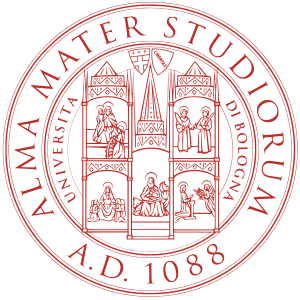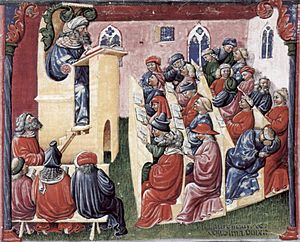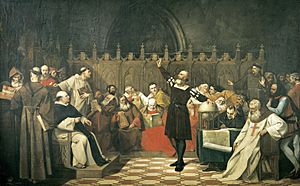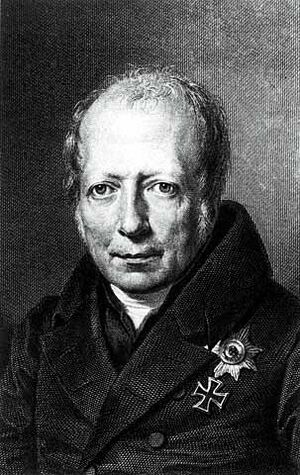History of European universities facts for kids
European universities are some of the oldest and most important schools in the world. They started a long time ago, with the University of Bologna in 1088 and the University of Paris around 1150. These early universities grew out of schools run by the Roman Catholic Church. Their main goals were to train people for jobs, explore new ideas through science, make society better, and teach students how to think critically and do research.
Over time, big changes in history shaped these universities. Events like the Renaissance (a time of new art and ideas), the discovery of the New World (America), the Protestant Reformation (changes in religion), and the Age of Enlightenment (a time of new ways of thinking) all made universities focus more on topics like human rights and international law.
In the 1800s and 1900s, European universities became very focused on science and research. Their ideas and structures helped create the modern university we know today. For example, the French Ecole Polytechnique was started in 1794 during the French Revolution. It became a military school under Napoleon I. In Germany, Wilhelm von Humboldt created a new university model based on ideas of freedom, seminars (small discussion groups), and laboratories. This model, like the French one, had strict rules. Universities focused on science, but they weren't open to everyone until after 1914. Also, until the late 1800s, religion had a big influence on what was taught and researched. Eventually, the German university model became a worldwide standard. The British also set up universities around the world, making higher education available to many people.
Contents
The First European Universities
Many people consider the University of Bologna, founded in 1088, to be the very first university in Europe. It's often called the "mother of European universities." While some people debate if it was truly the first "university" in the modern sense, official records and experts agree it's the oldest continuously operating university in the world.
If a "university" means a single group of students and teachers from different subjects, then the University of Paris, founded in 1208, might be considered the first.
The rediscovery of old Greek and Roman knowledge, like the writings of Aristotle and Roman law, led to the creation of student groups called universitates. These groups eventually became the universities we know. The traditional medieval universities, which grew from Catholic church schools, then created special ways to teach more students to become professionals.
At first, universities mainly trained students to become priests, lawyers, government workers, and doctors. But finding old classical knowledge changed universities. They started to seek "knowledge for the sake of knowledge" itself, not just for practical jobs. By the 1500s, this was seen as important for society. So, academic research began to focus on scientific investigation, as science became a key part of university studies. This meant being "open to new ideas" to find ways to control nature for the good of society.
How Early European Universities Grew
European universities spread for a few reasons. Sometimes, groups of students and teachers would leave an existing university to start their own, promoting their own ideas. For example, the University of Paris helped create many universities in Northern Europe, while the University of Bologna helped create many in the South.
Some leaders also started universities to gain more political power and popularity. For instance, Frederick II, Holy Roman Emperor founded the University of Naples in 1224. He wanted to train lawyers and administrators who could challenge the influence of the University of Bologna, which supported his enemies. Also, in 1218, King Alfonso IX founded the University of Salamanca. This is the oldest university in the Hispanic world and one of the oldest still operating today.
Early university classes involved a master (teacher) reading from texts and explaining them. Students also learned by teaching each other. Masters would also present "disputed questions" for their classes to discuss. By the 1700s, professors started to focus less on just training future teachers and more on "shaping the minds of the elite" in society.
New Ideas and Outside Influences
By the 1500s, the ideas of Renaissance humanism were slowly being accepted. These ideas spread from France to Germany and then to England during the Protestant Reformation (1517). With humanism, university education began to include preparing students for a civilized life, focusing on culture, good manners, and public affairs.
To do this, the curriculum included the liberal arts. These were divided into the trivium (which included grammar, rhetoric, and logic) and the quadrivium (which included arithmetic, geometry, astronomy, and music). These subjects prepared students for more specialized studies in theology (religion), law, or medicine.
In 1492, the discovery of the New World had a big impact on university studies. Topics like human rights and international law became very important. The way Europeans treated the native people they conquered in the Americas raised ethical questions in Europe. These questions were influenced by Renaissance humanism, the Bible, and older ideas about natural law.
By the mid-1500s, scholarly and scientific journals made it easier to share new ideas among educated people. By the 1700s, universities even started publishing their own research journals. The Age of Enlightenment in the 1700s also changed education. It shifted from just "keeping and passing on accepted knowledge" to "discovering and advancing new knowledge." Newer universities adopted these Enlightenment ideas more quickly than older ones.
European University Models in the 1800s and 1900s
Modern Universities Emerge

In the 1800s, universities changed their goal from simply making students memorize facts to "encouraging productive thinking." Two new university models appeared: the German model and the French Grandes écoles (elite schools). These models influenced older ones, like those in Russia and Britain.
These changes were linked to the Age of Enlightenment, the rise of the middle class during the Industrial Revolution, and the decline of older ways of thinking. However, the German and French models used different approaches. In Britain, older universities like Oxford and Cambridge had already started free thinking and experimentation in the 1600s, with scientists like Robert Hooke, Robert Boyle, and Isaac Newton.
In Germany, things were different. After Napoleon's armies defeated Prussia in 1806, the government was weak, which allowed for big reforms. Wilhelm von Humboldt led these reforms in education in 1809. He helped create a new system, including the University of Berlin. Based on his and Friedrich Schleiermacher's ideas, the goal was to show how knowledge is discovered and teach students to think scientifically. This is when seminars and laboratories started to become common.
Humboldt believed that university education should be student-focused research. He said that professors should not just be teachers, and students should not just be pupils. Instead, students should do their own research, and professors should guide and support them. Early American educators were very interested in these German ideas. For example, the Michigan Constitution of 1835 adopted parts of the Prussian system, creating a range of schools and the University of Michigan, all supported by taxes.
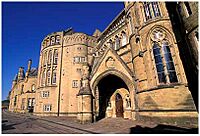
Freedom was a key idea in the German university model. Professors had freedom in their teaching and research. Even though they worked for the state, they could choose which state to work in. Their reputation came from specializing in scientific fields.
The French university model was less free than the German one. It had strict rules about what was taught, how degrees were given, what views were allowed, and even personal habits (like banning beards in 1852). French professors were trained at the École Normale Supérieure, and their prestige often came from their school's reputation. However, by 1866, the German model began to influence the strict French system. The École Polytechnique, founded in 1794, became a military academy under Napoleon and is still overseen by the French Ministry of Defence today.
The German university model also influenced Russian universities. They hired German-trained lecturers and focused on science. At the same time, Russian universities also aimed to train government workers, similar to the French grandes écoles. Throughout the 1800s and 1900s, Russian universities varied in how strict they were.
British universities also adopted some ideas from German universities. However, they already had a lot of freedom and independence, and changes there had started earlier with the Age of Enlightenment. Universities like Oxford and Cambridge emphasized research. Some argue they even better put Humboldt's idea of a university into practice than German universities, which were controlled by the state.
Overall, science became the main focus of universities in the 1800s and 1900s. Students could do research in seminars or laboratories and started writing doctoral theses with more scientific content. The German university system encouraged professional, organized scientific research in well-equipped laboratories, unlike the individual research done by scholars in Britain and France. Many experts believe the German system is responsible for the development of the modern research university because it focused on the idea of "freedom of scientific research, teaching, and study."
Professors and Students

Friedrich Schleiermacher believed that professors should show students how knowledge is created. They should be models of how to "intelligently produce knowledge." Professorships were given to distinguished scholars and could only be taken away for serious crimes. In the 1900s, European professors were highly respected and had a lot of academic freedom, though they kept formal relationships with students. Their job expanded from just lecturing to also doing research, making research a key part of a professor's work.
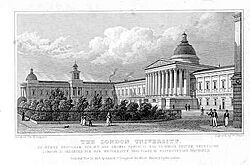
More people slowly gained access to higher education after 1914, but the cost was still a major barrier. For most of the 1800s, only wealthy people could afford a university education in the UK. It wasn't until the early 1900s, with new universities like the University of London, that higher education became available to more people.
Also, it wasn't until the mid-1800s that universities started admitting women. Women faced many challenges, including not having civil rights and facing sexism that questioned their intelligence and their right to a university education. When students from middle- and working-class backgrounds started attending universities, it challenged the German model's ideas. These students had different backgrounds and expectations, leading to a less strictly "Humboldtian" university.
In the 1800s and 1900s, European university students were largely responsible for their own education. They chose their courses, professors didn't take attendance, and exams were usually only given at the end of a course. Students often formed student movements based on current politics, showing their intellectual freedom and social responsibility.
Progressive ideas about education and politics changed the role of religion in universities. In the 1700s, most universities were strongly connected to either a Catholic or Protestant church. A person's religion often decided if they could be hired as a professor or admitted as a student.
In the 1800s, religion was removed from the "compulsory curriculum." In France, Napoleon's secular Université de France worried Roman Catholics because it threatened their control over education. A law in 1850 tried to give some educational power back to the Catholic Church. But by then, the Université de France already had strong control over French higher education. Similarly, in the UK, the new University of London was open to all religions. Laws passed in 1854 and 1856 removed religious requirements for students at Oxford and Cambridge. This led to less chapel attendance and religion becoming less central to a university education.
The European University Legacy
European universities created the intellectual and academic traditions for university education around the world. By the late 1800s, the Humboldtian university model was used in Europe, the US, and Japan.
In the Americas, the Spanish, British, and French founded universities in the lands they conquered starting in the early 1500s. These universities were meant to educate their colonists and spread monotheistic religion to help establish formal rule over their colonies. The British did similar things in Canada, Australia, and the Cape Colony. Japan, the Near East, and Africa all had universities based on European models in the 1800s.
These universities spread Western European science and technology. They also trained local people (especially the elite) to develop their countries' resources. While most promoted the goals of the imperial rulers, some also encouraged revolutionary changes in the colonial societies. In the 1900s, urbanization (more people living in cities) and industrialization (more factories) made university education available to many more people. Throughout all these changes, the basic structure and research goals of universities have stayed mostly the same.
See also


